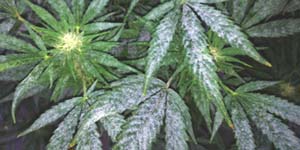
8 Life-threatening Diseases with Cannabis Plants
The leaves provide information about life-threatening diseases as well. Every disease has specific symptoms. In this article we will learn how to recognize, prevent and fight these diseases. The diseases:
- Mite
- Aphid
- Mealy bug
- Snails
- Powdery mildew and downy mildew
- Thrips
- Leaf miner
- Fungus gnats
The differences of symptoms of a disease compared to a shortage in the diet is that symptoms often quickly worsen. It starts for example with a small white spot, and a week later the whole plant turns white because of the fungi. Fungi and insects can multiply at a rapid pace, and literally eat the cannabis plant.
1. Mite
"Help! Cobwebs in my cannabis plant!" Even though your cannabis plant looks buried by the cobwebs, it is not. I wish it was the case. Spiders are predators and eat many of the common insects on cannabis plants. If your cannabis plant seems to be covered by cobwebs, it is thanks to mite. Spider mite is disastrous for your cannabis plant. It is an infectious disease caused by, among other things, the red spider mite (Tetranychus urticae), generally known as spider mite.
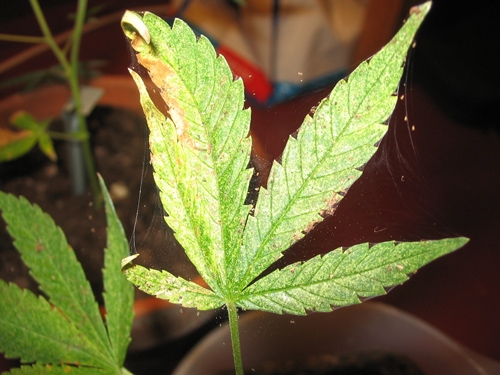
Spider mite: the plant leech
Spider mite quickly builds up a whole network of fine rag that suffocates the cannabis plant. This rag is the signature of the spider. This is one of the things you will recognize these annoying creatures by. However, the fact your cannabis plant gets slowly suffocated, is not even the worst.
The worst thing for the cannabis plant is the fact mites feed on your cannabis plant. It is a plant leech. Spider mite feed on the underside of the cannabis leaves. At the top of the cannabis leaves you see tiny, dark spots. This plant leech lives on the transport fluid (phloem) of the cannabis plant. As a result, important nutrients from the cannabis plant no longer reach the place where the plant needs them. The consequence? Cannabis leaves fall off and its yield is seriously reduced and polluted. In the worst case, the cannabis plant dies.
Preventing spider mite
Of course, you want your beloved cannabis plant to be saved this horror. Fortunately, there are two things that spider mite does not like:
- Low temperatures
- Humidity
However, a cannabis plant also does not like low temperatures. Just like spider mite, cannabis prefers a nice warm environment. Therefore, lowering the temperature is not a solution. Instead, maintain humidity around the cannabis plant. Ensure a maximum humidity in the growth phase and 40% to 60% during the flowering phase of the cannabis plant.
TIP: put a cup of water on the radiator to increase the humidity and use a hygrometer to evaluate the humidity.
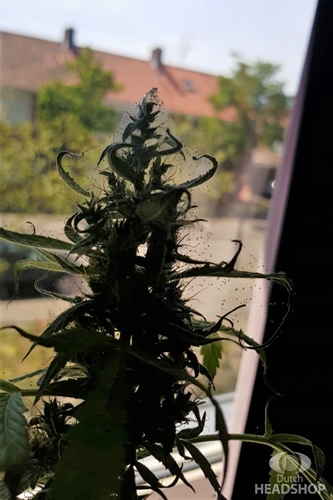
Fighting spider mite
You are unlucky, and your cannabis plant suffers from spider mite? No panic. Your cannabis plant can still be saved. You can provide an organic solution to spider mite by offering an alternative. A good example is a head of lettuce and treating the soil with garlic extract.
Step 1. Offer an Alternative
Hang the head of lettuce above the cannabis plant. Put a few sticks in the head of lettuce and ensure they are connected to the cannabis plant. You build sort of a bridge between the cannabis plant and the head of lettuce.
Step 2. Garlic
As every vampire story tells us, leeches do not like garlic. This also applies to spider mites. Spider mite does not like the garlic scent. By treating the soil with garlic extract, the plant gets a garlic-like smell. Do not worry. For us the smell is not strong enough to notice. Your cannabis will not taste like garlic if you later roll a fat joint with it. Spider mites, on the other hand, are very sensitive and prefer to look for something else. Think of, the head of lettuce. Within a day or two, most of the creatures have walked over the thin sticks to the lettuce and you can just throw away the head of lettuce. Repeat if necessary.
Spider mites, but also thrips (discussed further on) do not like the smell of garlic at all. Therefore, be sure to plant some cloves of garlic around the cannabis plant.
Stubborn or acute spider mite?
Your cannabis plant is full of spider mite, within a short amount of time? You can also fight spider mites by introducing natural enemies like predatory mites, predator bugs or gall midge. We do not recommend you to use chemical pesticides. You don’t want these agents in your flower tops.
2. Aphid
Aphids (Aphidoidea) are miniature insects that eat holes in the leaves. They come in black, gray, green and orange. Still, the color makes little difference for how annoying they are for growing cannabis.
Fighting aphids
Aphids can be easily controlled with natural enemies. Green lacewings, parasitic wasps and ladybugs are welcome guests. These natural enemies, and easy to order online.
You prefer to have no additional insects in your growing environment? Rinse the cannabis plant with cold water. Aphids cannot tolerate that. You will have to repeat it a few times before the aphid runs away, but it is the simplest way to combat aphids.
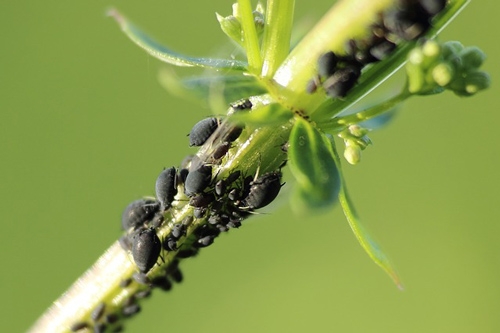
Photo by Jared Belson
Preventing aphids
The best thing is, of course, to never get aphids. Fortunately, aphids are only a real problem in case of outdoor plants. Aphids do not like fragrant plants like chives and lemongrass. And these are exactly plants that do well indoors. Put some herbs in a jar next to your plants, to prevent aphids.
3. Mealy bug
Mealybugs (Pseudococcidae) come, like aphids, in all shapes and sizes. In case of a mealy bug infection, the cannabis plant seems to be full of white speckles. The lice, eggs and larvae are all white in color. The mealy bug eats the sap (phloem) of the cannabis plant, by biting into the plant. Because of this, the cannabis plant struggles sending essential nutrition to the right places. The longer the cannabis plant is suffering from mealybug, the greater the chance the cannabis plant will die off.
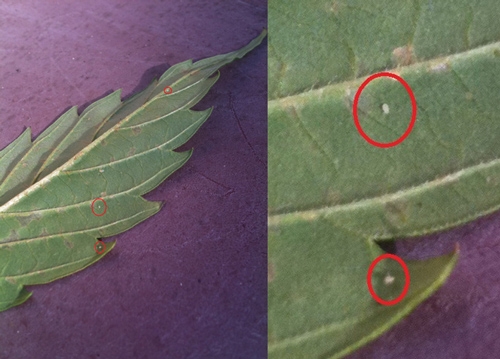
Fighting mealybugs
In contrast to aphids, mealybugs are pretty comfortable in the cold. Rinsing with cold water does not make much sense. Mealybugs repel water with their bodies, so it's difficult to remove them with water or pesticides. What does work?
Mealybugs...
- share the same natural enemies as aphids: green lacewings, parasitic wasps and ladybugs.
- they are no fan of coriander and onion. Put an onion close by in the soil (but not in the same pot), and the smell will chase away the lice.
- Eggplant and potatoes, on the other hand, are great meals for the mealybugs! You probably have a potato left to put in another jar close by. Is the potato plant full? Dispose of it properly, and repeat until the white creatures have left.
4. Snails
They are not very common inside, but they are outside. Snails eat all parts of your cannabis plant.
Fighting Snails
Also for snails, you can provide a better alternative. Put a much tastier plant near the cannabis plant, such as the hosta. This prevents and removes snail pests. Not a tasty plant in the surroundings? Put (a piece of) lettuce on the ground a bit further away. Snails will ‘quickly’ turn around heading for the lettuce.
Another solution for a snail plague is to fence off the cannabis plants with copper tape. Stick it around the flower pot, for example. Snails hate copper, and won't crawl over it.
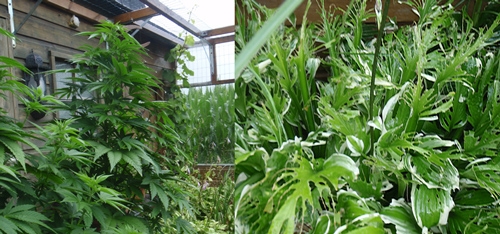
The hosta (right) became the target of the snail plague, while the cannabis plant next to it remains unaffected (left).
Snails or mold?
The lime remnants of a snail's trail sometimes resemble fungi. How do you know whether you are dealing with a snail plague, or with mold? The biggest difference between a snail's trail and mold is you can follow a snail's trail. The track is a sort of shortcut through the plant. With mold, this is not the case. Fungi descend on the cannabis plant from the air at irregular places.
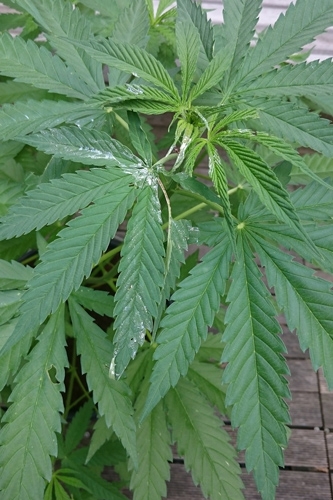
No mold, but an old snail's trail. Also check out the characteristic large hole in the lower left leaf.
5. Mildew
The most common fungal infection in cannabis plants is mildew. Mildew often starts with white-gray spots on the cannabis plant's bracts. Over time, the cannabis leaves turn white. Your harvest as well.
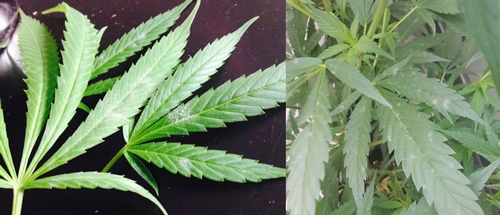
Powdery mildew and downy mildew?
There is a lot of confusion between powdery mildew and downy mildew. Both fungi are disastrous for the plant, but the fungi develop in different ways, and the control is slightly different.
Powdery mildew
Powdery mildew develops on the top of the cannabis leaves. The clinical picture of the incipient powdery plague evolves into a white fluff covering the entire cannabis plant. The bottom of the cannabis leaves as well. Powdery mildew makes its way into the cell wall, and then extracts the nutrients and water. The result are curly, withered cannabis leaves that slowly die off.
In the beginning, powdery mildew is easy to clean off the leaves, but this doesn't make any difference. Brushing is only useful for distinguishing powdery mildew from downy mildew. You can't brush off downy mildew from the leaves. Prevening powdery mildew is first of all done by proper ventilation and not planting the plants too close to one another. Furthermore, powdery mildew required dry conditions for germinating, so ensure the right humidity and provide enough water in case of drought.
What is the right humidity for a cannabis plant? Read Leaf problems with cannabis plants Part 1: How to prevent problems »
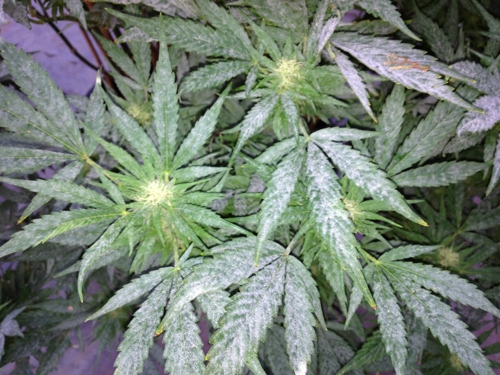
Fighting Powdery mildew
The control of powdery mildew is possible by pollinating the cannabis plants with fungicidal pesticides or by spraying the infected plant with a sulfur-containing solution. Such a pesticide against powdery mildew is commercially available.
However, the use of a pesticide is not strictly necessary. You can also make one yourself. Use one part of milk on nine parts of water. The proteins in the milk spray break down the fungi. Be sure to put the cannabis plant in full sun with this remedy. Only that way this remedy works well. Repeat the spraying every ten days, so the mildew does not have a chance to return. For an extra strong effect, you can add sodium carbonate (soda) to the diluted milk.
Downy mildew - The Leaf Spot Disease
Apart from powdery mildew, you also have downy mildew. Downy mildew or leaf spot disease appears on the bottom side of the cannabis leaves as a gray fluff. This fungus grow on the tissue of the cannabis plant. Therefore, the stains - unlike powdery mildew - cannot be brushed off the leaves. Because the fungi grow into the tissue, the top of the cannabis leaves get yellow, angular spots. At a later stage, these spots can turn brown.
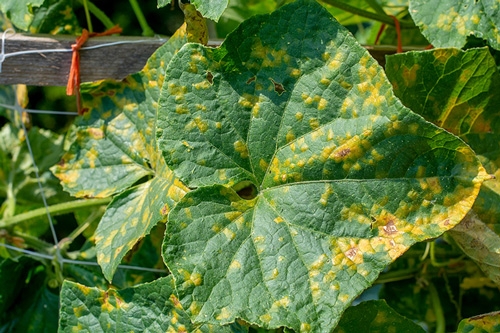
To illustrate downy mildew, see the spots on the leaves of the plant in the above picture. Of course this is no cannabis plant, but the spots look exactly the same.
Fighting Downy Mildew
You can combat downy mildew by pollinating the cannabis plant with a copper sulfide solution. You prefer a natural remedy? Grind the herb horsetail and dissolve it in water. Use 100 grams of fresh horsetail and let it soak in a liter of water for 24 hours. Sieve the plant residue out of the mixture and spray it on the weed plant in the morning.
The leaves are very badly hurt? Then remove them. A cannabis leaf that slowly dies off only causes unnecessary waste of water and food.
Preventing Downy mildew
An ounce of prevention is worth a pound of cure. Unfortunately, downy mildew - like the cannabis plant itself - needs moisture to germinate. As you maintain the air humidity on purpose for the cannabis plant, this fungus is more difficult to prevent. Nonetheless, there are a number of more reliable precautions:
- Don't give more water than necessary (read more about the basic needs of a cannabis plant).
- Keep the pot and soil free of weeds.
- Water the soil, don't water over the leaves.
- Ensure adequate ventilation. Don't put the cannabis plants too close together.
- Give water in the morning - the cannabis plant will dry faster and fungi get fewer chances.
6. Thrips
Back to the insect pests at the cannabis plant. Unfortunately, we haven't finished yet. Thrips (Thysanoptera), like mealybugs and spins, are nasty dredgers.
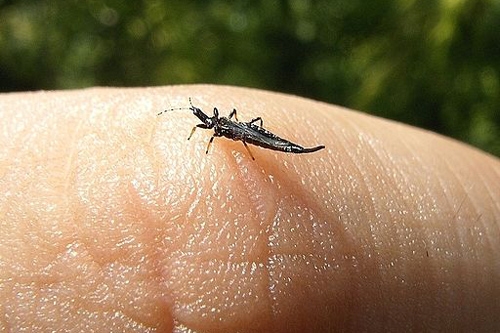
These microscopic insects are almost invisible to the naked eye. Still, recognizing a thrips plague is quite simple. Trips leaves irregular silver or gold spots on marijuana plants. In light, the spots even seem to shine, and they somewhat resemble miniature snail traces. The pattern on the leaves look a bit like random, small camouflage patterns in case of a heavy attack.
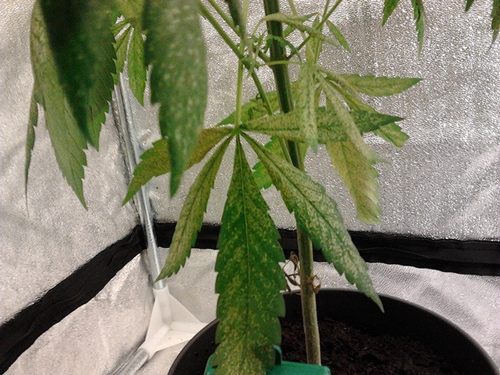
Fighting Thrips
Thrips on your cannabis plant? Both the larvae and adult thrips puncture the cells of healthy plants. If thrips thrive on the flower buds, strange deformities may occur. Over time, the plant will dry out and die. All sap-sucking insects cause this disease progress, and the control is the same. Introduce natural enemies: predatory bug, predatory mite or ladybugs.
Your prefer not to use natural enemies? Then go for the so-called blue catch plates. Thrips love the color blue. However, as these plates are treated with glue, the thrips stick. Therefore, hang these plates above the cannabis plant as a solution.
Preventing Thrips
You prefer avoiding thrips? Also for thrips, these insects do not like garlic. A few cloves of garlic in the pot or in the soil work well against both thrips and spider mites.
7. Leaf miner
Help! You have crazy brown circles on your cannabis plant? That is a leaf miner. These miners of the insect world create a true tunnel system in the cannabis leaf. As if a tiny mole went crazy on the leaf. Traces of the leaf miners can also be seen on both sides of the leaf.
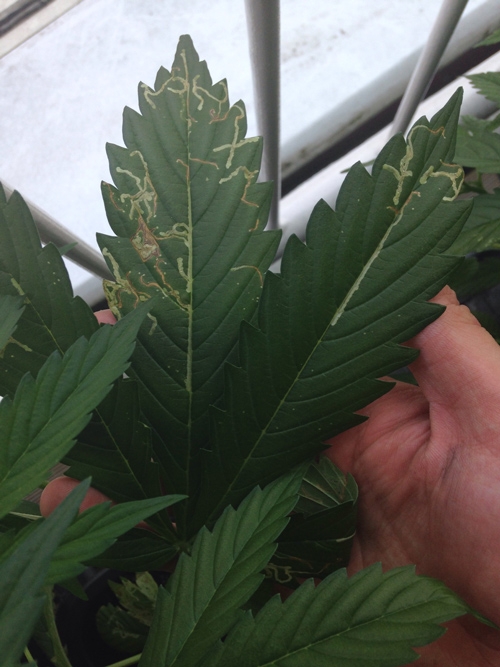
A leaf miner is not an insect species, but a collective name for larvae of certain leaf wasps, moths, flies and beetles that are fond of the innermost part of the leaf. The corridors that these creatures leave behind are white, yellow or brown in color.
Fighting leaf miners
By the time you see visible traces of leaf miners, it is too late. Evil has already happened. The good news is it does not have to get worse. Usually there will only be a few traces. Furthermore, the leaf miner is more common on fruit trees than on cannabis plants.
Nevertheless, you can certainly do something against these leaf miners. Introduce the natural enemy of these insects: the parasitic wasp. It is by far the best way to fight against these cannabis destroyers, without having to spray your precious buds with chemicals.
8. Fungus gnats
A less common pest is fungus gnats (Sciara analis). These 3 mm mosquitoes are not particularly harmful to your cannabis plant, but a few mosquitoes can lay hundreds of eggs in a week. The larvae coming out of there, are indeed harmful to the plant. The larvae feed on the roots of the cannabis plant. In particular the roots of young cannabis plants.
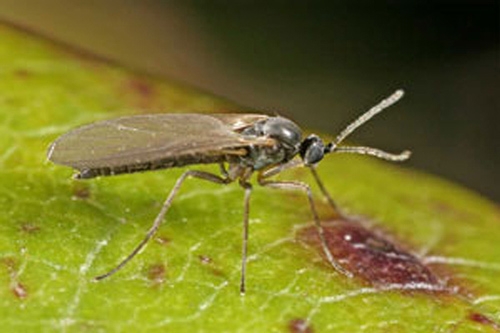
How do you recognize fungus gnats?
A fungus gnat is not big, and the harmful larvae reside inside the ground. So how do you recognize a fungus gnat plague? When roots start to suffer from the nibbling larvae, you will notice this in the cannabis leaves. Cannabis leaves turn pale and get brown, dead edges while leaves start to hang and curl. The same symptoms are equal to that of a significant nitrogen or zinc shortage. However, if you put your finger in the ground at a few spots, a bunch of mosquitoes fly away in panic. If this happens, it is time to take measures.
Fighting fungus gnats
You can avoid most mosquitoes by leaving no water or dead plant material in the pot. The same applies to the fungus gnat. Fighting the organic way is done by dissolving a large amount of cinnamon in water. Cinnamon easily dissolves in hot water, but first let it cool down before you start treating the soil. The natural enemy of fungus gnats are nematodes.
Want to know more? Back to the basics!
Cannabis plants can endure a lot during their lifetime. From fungal infections to uninvited guests with too many paws. Fortunately, there is almost always something you can do about it. We hope this series of articles has brought you knowledge about common problems with cannabis plants.
In the first instance, make sure the basis is good. Read the article on Basics of growing cannabis. Water, soil, air and environment are ok? Then check the Specific nutritional deficiencies of the plant. Strange spots or creatures? Chances are this is one of the discussed diseases or pests.